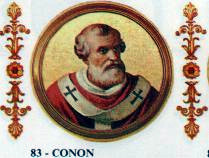Pope Conon
Pope Conon | |
|---|---|
 | |
| Papacy began | 21 October 686 |
| Papacy ended | 21 September 687 |
| Predecessor | John V |
| Successor | Sergius I |
| Orders | |
| Created cardinal | 1 May 683 by Leo II |
| Personal details | |
| Born | Kónon |
| Died | 21 September 687 (aged 57) Rome, Byzantine Empire |
| Previous post(s) | Cardinal-Deacon (683-86) |
Pope Conon (d. 21 September 687) was Pope from 21 October 686 to his death in 687.[1] He had been put forward as a compromise candidate, there being a conflict between the two factions resident in Rome— the military and the clerical. On his death, Conon was buried in the Patriarchal Basilica of St. Peter. He consecrated the Irish missionary Kilian a bishop and commissioned him to preach in Franconia.
Life
A Greek according to the Liber pontificalis, Conon was the son of an officer from the Thracesian Theme. He was educated in Sicily, where his father may have been posted during the stay of Constans II, and was later ordained a priest at Rome. He may have been among the many Sicilian clergy in Rome, at that time, due to the Islamic Caliphate raids on Sicily in the mid-7th century.[2] His age, venerable appearance, and simple character caused the clergy and soldiery of Rome, who were in disagreement, to put aside their respective candidates and to elect him as pope. Andrew J. Ekonomou says that due to an "increasing influx" of Easterners into Rome at that time, that the Syrian, Greek, and Greco-Sicilian population together outnumbered the Latins. This would also have increased Conon's electability.[3]
He was consecrated on October 21, 686 after notice of his election had been sent to the Exarch of Ravenna, or after it had been confirmed by him.[1]
He received the Irish missionaries Saint Kilian and his companions, consecrated Kilian bishop, and commissioned him and the others to preach the faith in Franconia. (Vita S. Kiliani, in Canisius, Lect. Antiquæ, III, 175–180.) He was in favour with Byzantine Emperor Justinian II, who informed him that he had recovered the Acts of the Third Council of Constantinople, by which, the Emperor wrote, it was his intention to abide. Justinian also remitted certain taxes and dues owing to the imperial exchequer from several papal patrimonies.[1]
See also
References
- ^ a b c Mann, Horace. "Pope Conon." The Catholic Encyclopedia Vol. 4. New York: Robert Appleton Company, 1908. 12 September 2017
- ^ Jeffrey Richards (1 May 2014). The Popes and the Papacy in the Early Middle Ages: 476-752. Routledge. p. 270. ISBN 9781317678175.
- ^ Ekonomou, Andrew J., Byzantine Rome and the Greek Popes, Lexington Books, 2007, p. 247, ISBN 9780739133866
![]() This article incorporates text from a publication now in the public domain: Herbermann, Charles, ed. (1913). "Pope Conon". Catholic Encyclopedia. New York: Robert Appleton Company.
This article incorporates text from a publication now in the public domain: Herbermann, Charles, ed. (1913). "Pope Conon". Catholic Encyclopedia. New York: Robert Appleton Company.
